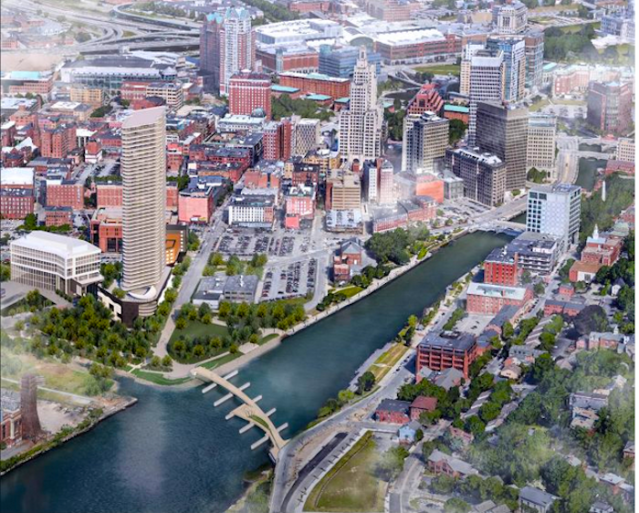
Recent rendering of proposed Hope Point Tower in city context. (Fane)
Learning nothing in its latest public hearing that it did not already know, the Ordinance Committee of Providence City Council reversed itself on Thursday to recommend that the council neuter the city’s zoning laws.
It voted three to one to urge the council to raise the height limit on Parcel 42 by a factor of six – 100 feet to 600 feet – for the Hope Point Tower proposed by developer Jason Fane. In July, the same committee voted three to one to recommend against the same zoning change. The only difference was that the first vote came before and the second vote after elections for city council seats. (Bravo for Bryan Principe, the only council member to stand firm.)
That doesn’t mean the Fane tower is now a done deal. The council could still ignore the recommendations of the committee. I don’t think these men and women are corrupt, I think they are held back by old thinking about cities. This old thinking is not the future but the past. It poses in high-tech dress and fools most of the people most of the time. It is corrupt, though a better word might be corrosive – a cancer on the livability, the value, the hopes and the spirit of cities.
For almost a century, American cities have adopted growth and development practices that call for purely functional buildings on purely functional streets. With beauty thrown on the ash heap, the resulting sterility and ugliness of cities caused dismay in most people back then and most people today. The promised efficiency never materialized.
In Providence, massive urban-renewal plans for downtown and College Hill fizzled in the 1960s, leaving our city as one of the few in America with its original beauty largely intact. But Providence’s civic leaders since then have never really understood the jewel they were in charge of. They have instead tried to “catch up” with cities like Hartford and Worcester that went all-in on the idea of cities as machines and people as cogs in them.
Before the city council votes to declare that Providence’s zoning laws are just a façade for copying the respectable failures of Hartford and Worcester, our deep thinkers should rethink this more progressively. A vote for the Fane tower is a vote for the GMO architecture of GTECH, the Rubik’s Cube and the I-195 corridor as built and planned so far. A vote against the Fane tower is not a vote against development but a vote against bad development.
If the council fails to grasp the need to turn the city back toward development that strengthens rather than weakens its historic character – whose loss will kill the city’s future – then it will not matter whether Fane builds his mammoth middle finger flung at all that we love about Providence.
If one American city decided to encourage development that its citizens could love, its skyline would be filled with cranes, and its future would be the envy of every other city. Providence can be that city if it wants to.



I tend to agree with Stan- I’m all about maintaining historic neighborhoods, but we should be embracing and welcoming the economic investment – look how much downtown has changed in the last 10 years, we are seeing growth and development and there are parts of the city that, with development and infrastructure will create cohesive feel – especially that corridor.
If there is any compromise to be made by the developers it should/could be a commitment to invest in surrounding infrastructure (roads, parks, public transit, etc.)
The zoning variance request isn’t for anything too far out of line, if as you say, the subject area is currently zoned for 100ft, an additional 20ft is not going to be the end of the world. We are not currently zoned for 30 ft and asking for a variance to 120ft – variances are granted all the time, rules and laws change quite frequently. We should keep in mind that by comparison to the new standard of modern planned cities and communities, the zoning laws in New England are a bit antiquated overall and could probably use a second look all the way around.
PVD should maintain its historic look and feel as a place of history and beauty, but instead of trying to fight the obvious economic growth potential, we should settle in, meet the new neighbors and prepare for our property values to increase!
LikeLike
An exception to the rule does not neuter the rule. Grammatically we live with valid exceptions, everything isn’t black or white. In real estate an exception has to be backed up with reasoning like the case for Prudential Center in Boston. And Providence hasn’t grown demographically since World War II. (All boats rise in the tide.) Let’s start growing vertically and create necessary urban density and repopulate our city, which has decreased 50,000 last century …
Sent from my iPhone Ok >
LikeLike
Disagree on both counts, Stan. This is not an exception to the rule, as it would be to allow 120 feet in a 100-foot zone, it is a change in the rule, as council recognized by not treating it as an exemption – a throwing out of a major facet of the zoning that upholds a comprehensive plan worked out by planning and the public over several years, and for a clear, rational purpose. Discarding something that big invites developers to assume that Providence officials are easy to roll and willing to be rolled.
Providence can get what it would want from the Fane tower through means that do not encourage the continuation of the destruction of its one great competitive advantage – its beauty. It can increase its population and its prosperity without sacrificing its delights as a medium-sized city. In fact, that would be easier and cheaper than its current policy.
LikeLike